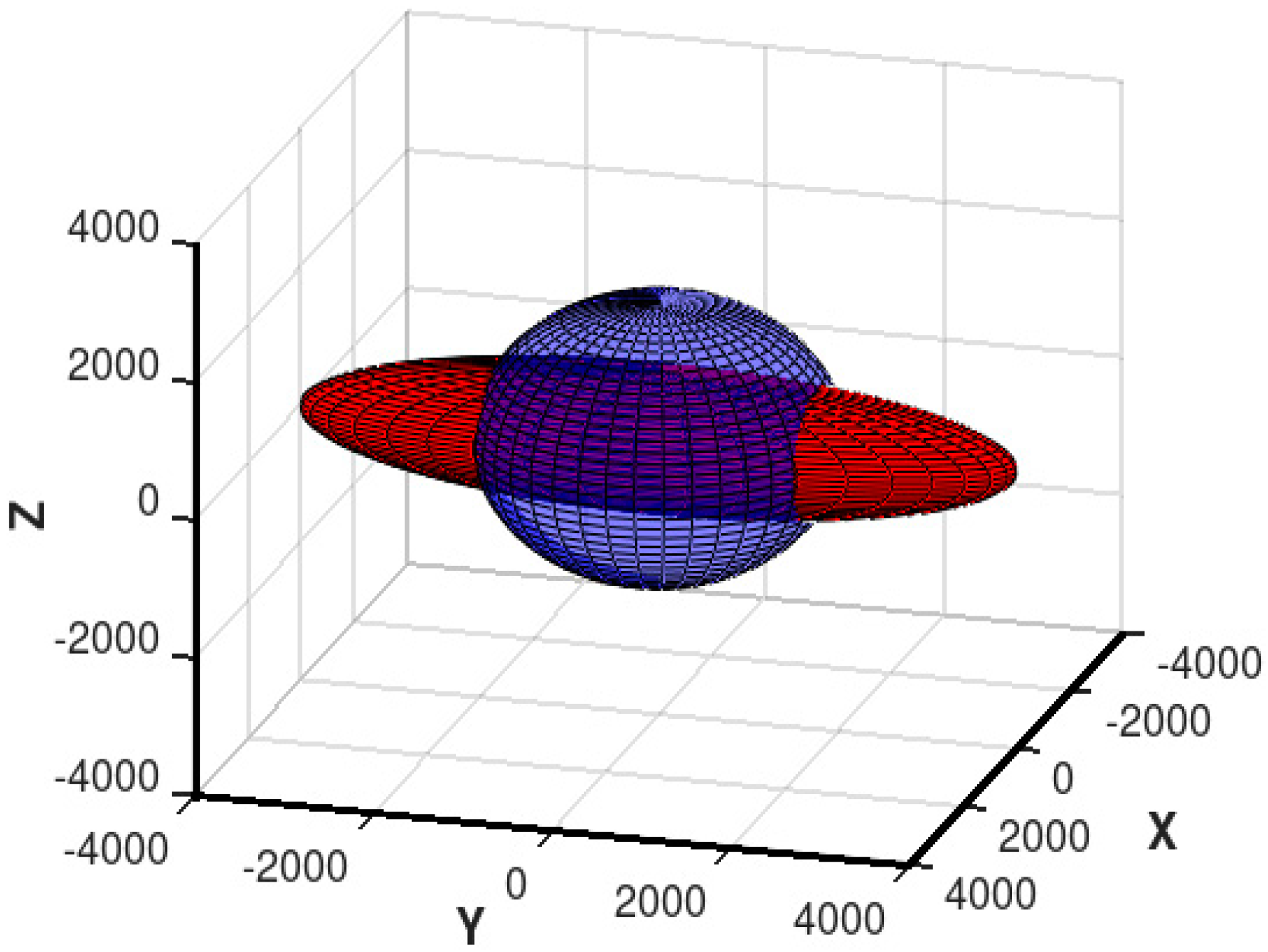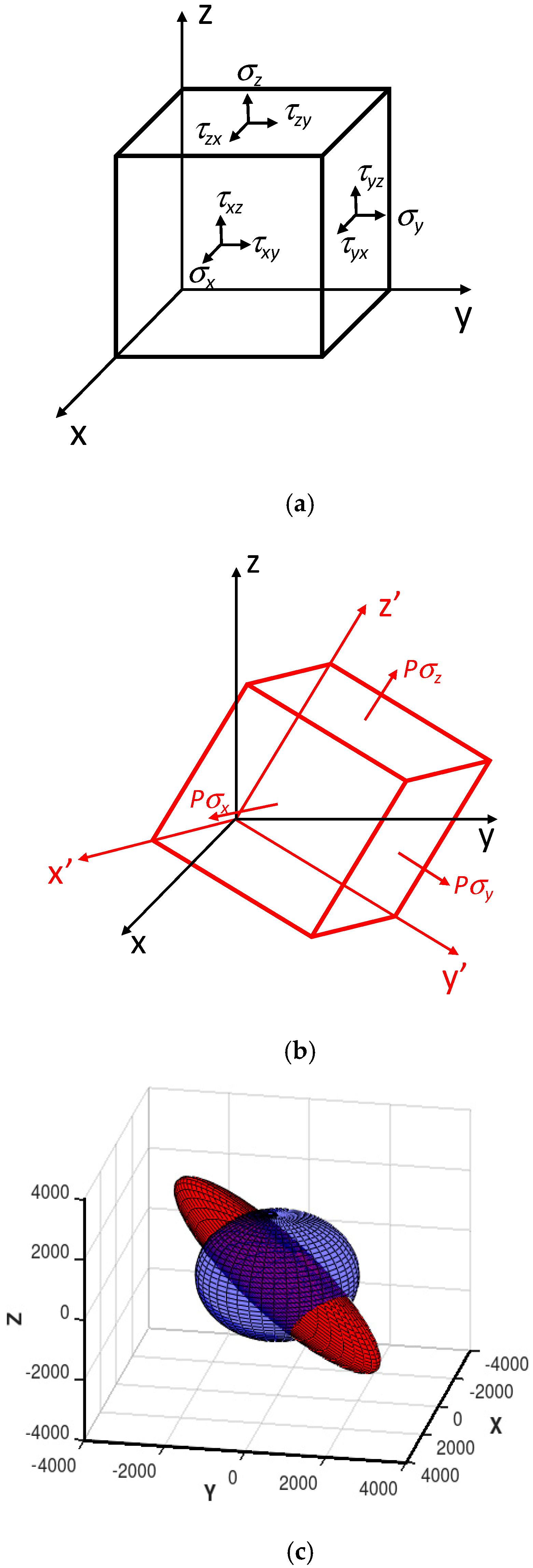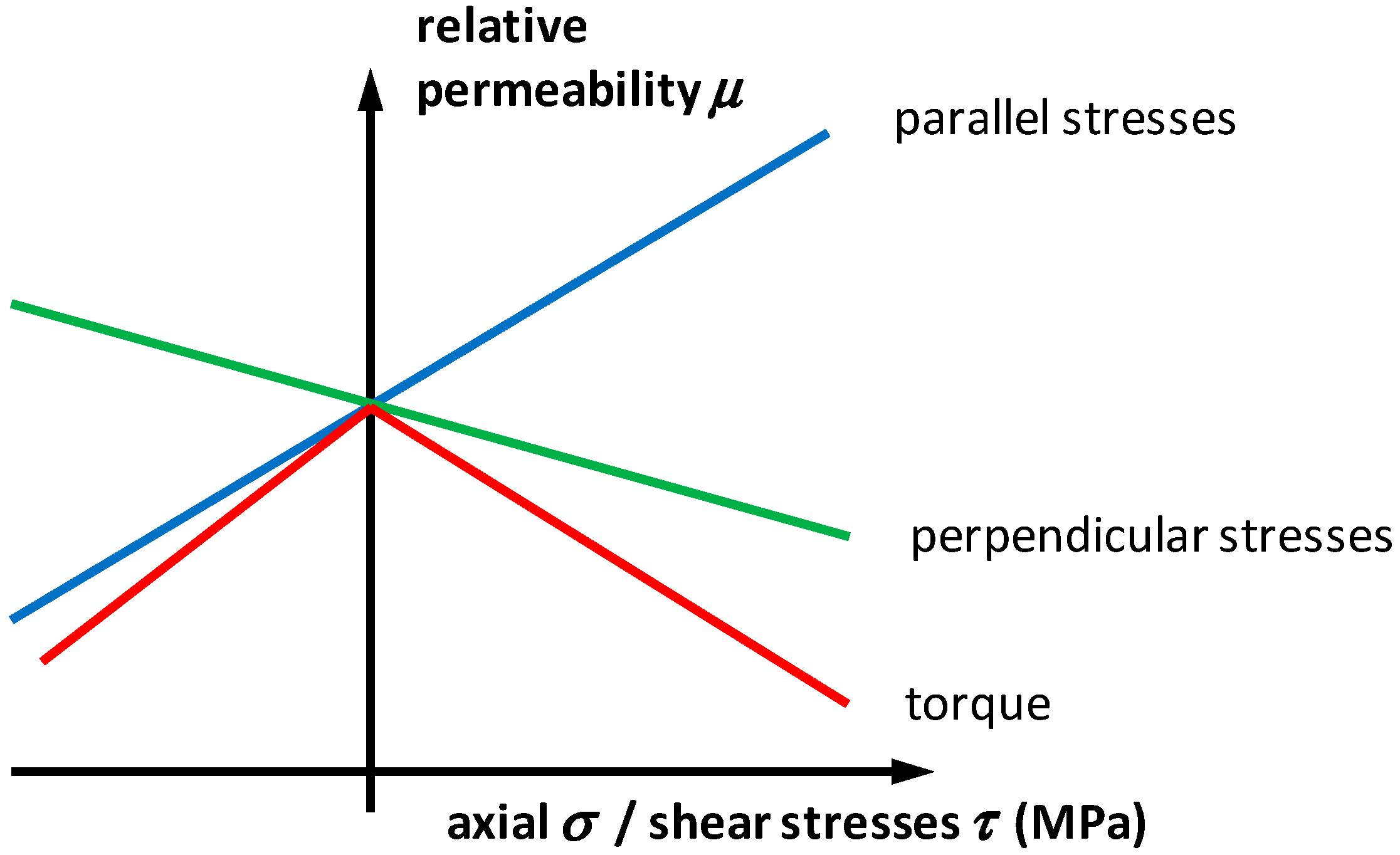Generalization of the Model of Magnetoelastic Effect: 3D Mechanical Stress Dependence of Magnetic Permeability Tensor in Soft Magnetic Materials
Abstract
1. Introduction
2. Model of the Magnetoelastic Effect
3. Proposed Description of the Mechanical Stress Dependence of 3D Magnetic Permeability Tensor
4. The Possibilities of Practical Use of Proposed Generalization
5. Conclusions
Funding
Conflicts of Interest
References
- Hristoforou, E.; Vourna, P.; Ktena, A.; Svec, P. On the Universality of the Dependence of Magnetic Parameters on Residual Stresses in Steels. IEEE Trans. Magn. 2016, 52, 1–6. [Google Scholar] [CrossRef]
- Singh, D.; Rasilo, P.; Martin, F.; Belahcen, A.; Arkkio, A. Effect of Mechanical Stress on Excess Loss of Electrical Steel Sheets. IEEE Trans. Magn. 2015, 51, 1–4. [Google Scholar] [CrossRef]
- Kraus, L.; Švec, P. Magnetoelastic hysteresis of amorphous ribbons. J. Appl. Phys. 2003, 93, 7220–7222. [Google Scholar] [CrossRef]
- García-Arribas, A.; Gutiérrez, J.; Kurlyandskaya, G.; Barandiarán, J.; Svalov, A.; Fernández, E.; Lasheras, A.; De Cos, D.; Bravo-Imaz, I. Sensor applications of soft magnetic materials based on magneto-impedance, magneto-elastic resonance and magneto-electricity. Sensors 2014, 14, 7602–7624. [Google Scholar] [CrossRef]
- Aydin, U.; Rasilo, P.; Martin, F.; Belahcen, A.; Daniel, L.; Haavisto, A.; Arkkio, A. Effect of multi-axial stress on iron losses of electrical steel sheets. J. Magn. Magn. Mater. 2019, 469, 19–27. [Google Scholar] [CrossRef]
- Oess, N.P.; Weisse, B.; Nelson, B.J. Magnetoelastic Strain Sensor for Optimized Assessment of Bone Fracture Fixation. IEEE Sens. J. 2009, 9, 961–968. [Google Scholar] [CrossRef][Green Version]
- Bieńkowski, A. Magnetoelastic Villari effect in Mn–Zn ferrites. J. Magn. Magn. Mater. 2000, 215, 231–233. [Google Scholar] [CrossRef]
- Herzer, G. Magnetoelastic Sensors for Electronic Article Surveillance. Sens. Lett. 2007, 5, 259–262. [Google Scholar] [CrossRef]
- Ahamada, B.; Alves, F.; Barrué, R. Improvement of magnetoelastic properties of nanocrystalline materials for magnetostrictive sensors. J. Magn. Magn. Mater. 2002, 242, 1443–1445. [Google Scholar] [CrossRef]
- Daniel, L. An analytical model for the magnetostriction strain of ferromagnetic materials subjected to multiaxial stress. Eur. Phys. J. Appl. Phys. 2018, 83, 30904. [Google Scholar] [CrossRef]
- Daniel, L.; Hubert, O. An analytical model for the ΔE effect in magnetic materials. Eur. Phys. J. Appl. Phys. 2009, 45, 31101. [Google Scholar] [CrossRef]
- Green, S.R.; Gianchandani, Y.B. Wireless magnetoelastic transducers for biomedical applications. Micro- and Nanotechnology Sensors, Systems, and Applications IX. Int. Soc. Opt. Photonics 2017, 10194, 1019412. [Google Scholar] [CrossRef]
- Kaniusas, E.; Pfutzner, H.; Mehnen, L.; Kosel, J.; Varoneckas, G.; Alonderis, A.; Meydan, T.; Vazquez, M.; Rohn, M.; Merlo, A.; et al. Magnetoelastic skin curvature sensor for biomedical applications. Proc. IEEE Sens. 2004. [Google Scholar] [CrossRef]
- Turner, J.D. The development of a thick-film non-contact shaft torque sensor for automotive applications. J. Phys. E Sci. Instrum. 1989, 22, 82–88. [Google Scholar] [CrossRef]
- Dahle, O. The pressductor and the torductor—Two heavy-duty transducers based on magnetic stress sensitivity. IEEE Trans. Commun. Electron. 1964, 83, 752–758. [Google Scholar] [CrossRef]
- Nowicki, M. Tensductor—Amorphous Alloy Based Magnetoelastic Tensile Force Sensor. Sensors 2018, 18, 4420. [Google Scholar] [CrossRef]
- Jiles, D. Introduction to Magnetism and Magnetic Materials; CRC Press: Boca Raton, FL, USA; Taylor & Francis Group: Oxfordshire, UK, 2016. [Google Scholar]
- Cullity, B.D.; Graham, C.D. Introduction to Magnetic Materials; IEEE/Wiley: Hoboken, NJ, USA, 2009. [Google Scholar]
- Bieńkowski, A.; Kulikowski, J. Effect of stresses on the magnetostriction of Ni-Zn(Co) ferrites. J. Magn. Magn. Mater. 1991, 101, 122–124. [Google Scholar] [CrossRef]
- Nowicki, M. Anhysteretic Magnetization Measurement Methods for Soft Magnetic Materials. Materials 2018, 11, 2021. [Google Scholar] [CrossRef]
- Ramesh, A.; Jiles, D.C.; Bi, Y. Generalization of hysteresis modeling to anisotropic materials. J. Appl. Phys. 1997, 81, 5585–5587. [Google Scholar] [CrossRef]
- Szewczyk, R. Validation of the Anhysteretic Magnetization Model for Soft Magnetic Materials with Perpendicular Anisotropy. Materials 2014, 7, 5109–5116. [Google Scholar] [CrossRef]
- Jiles, D.; Atherton, D. Theory of ferromagnetic hysteresis. J. Magn. Magn. Mater. 1986, 61, 48–60. [Google Scholar] [CrossRef]
- Bordin, G.; Buttino, G.; Cecchetti, A.; Poppi, M. Magnetoelastic effects in soft nanocrystalline Fe-based alloys. J. Magn. Magn. Mater. 1995, 150, 363–370. [Google Scholar] [CrossRef]
- Barandiaran, J.; Gutierrez, J. Magnetoelastic sensors based on soft amorphous magnetic alloys. Sens. Actuators A Phys. 1997, 59, 38–42. [Google Scholar] [CrossRef]
- Kwun, H. Investigation of the dependence of Barkhausen noise on stress and the angle between the stress and magnetization directions. J. Magn. Magn. Mater. 1985, 49, 235–240. [Google Scholar] [CrossRef]
- Sablik, M.J.; Rubin, S.W.; Riley, L.A.; Jiles, D.C.; Kaminski, D.A.; Biner, S.B. A model for hysteretic magnetic properties under the application of noncoaxial stress and field. J. Appl. Phys. 1993, 74, 480–488. [Google Scholar] [CrossRef]
- Riley, W.F.; Sturges, L.D.; Morris, D.H. Mechanics of Materials; John Wiley & Sons: Hoboken, NJ, USA, 2007. [Google Scholar]
- Davis, R.O.; Selvadurai, A.P.S. Elasticity and Geomechanics; Cambridge University Press: Cambridge, UK, 2009. [Google Scholar]
- Beer, F.P.; Johnston, E.R.; DeWolf, J.T.; Mazurek, D.F. Mechanics of Materials; McGraw-Hill Education: New York, NY, USA, 2020. [Google Scholar]
- Stuelpnagel, J. On the Parametrization of the Three-Dimensional Rotation Group. Siam Rev. 1964, 6, 422–430. [Google Scholar] [CrossRef]
- Szewczyk, R.; Nowicki, M.; Ostaszewska-Liżewska, A.; Bieńkowski, A.; Nowak, P.; Malinen, M. Accuracy of frame-shaped samples based measurements of magnetoelastic characteristics of soft magnetic materials. Measurement 2020, 162, 107899. [Google Scholar] [CrossRef]
- Lesz, S.; Szewczyk, R.; Szewieczek, D.; Bieńkowski, A. The structure and magnetoelastic properties of the Fe-based amorphous alloy with Hf addition. J. Mater. Process. Technol. 2004, 157, 743–748. [Google Scholar] [CrossRef]
- Andreescu, R.; Spellman, B.; Furlani, E. Analysis of a non-contact magnetoelastic torque transducer. J. Magn. Magn. Mater. 2008, 320, 1827–1833. [Google Scholar] [CrossRef]
- Salach, J.; Bieńkowski, A.; Szewczyk, R. The ring-shaped magnetoelastic torque sensors utilizing soft amorphous magnetic materials. J. Magn. Magn. Mater. 2007, 316. [Google Scholar] [CrossRef]
- Råback, P.; Mika, M.; Ruokolainen, J.; Antti, P.; Zwinger, T. Elmer Models Manual. 2009. Available online: https://www.nic.funet.fi/pub/sci/physics/elmer/doc/ElmerModelsManual.pdf (accessed on 23 July 2020).
- Bieńkowski, A. Magnetoelastic hysteresis in ferrites. J. Magn. Magn. Mater. 1982, 26, 287–291. [Google Scholar] [CrossRef]
- Kraus, L.; Švec, P.; Bydžovský, J. Amorphous CoFeCrSiB ribbons for strain sensing applications. J. Magn. Magn. Mater. 2002, 242, 241–243. [Google Scholar] [CrossRef]



© 2020 by the author. Licensee MDPI, Basel, Switzerland. This article is an open access article distributed under the terms and conditions of the Creative Commons Attribution (CC BY) license (http://creativecommons.org/licenses/by/4.0/).
Share and Cite
Szewczyk, R. Generalization of the Model of Magnetoelastic Effect: 3D Mechanical Stress Dependence of Magnetic Permeability Tensor in Soft Magnetic Materials. Materials 2020, 13, 4070. https://doi.org/10.3390/ma13184070
Szewczyk R. Generalization of the Model of Magnetoelastic Effect: 3D Mechanical Stress Dependence of Magnetic Permeability Tensor in Soft Magnetic Materials. Materials. 2020; 13(18):4070. https://doi.org/10.3390/ma13184070
Chicago/Turabian StyleSzewczyk, Roman. 2020. "Generalization of the Model of Magnetoelastic Effect: 3D Mechanical Stress Dependence of Magnetic Permeability Tensor in Soft Magnetic Materials" Materials 13, no. 18: 4070. https://doi.org/10.3390/ma13184070
APA StyleSzewczyk, R. (2020). Generalization of the Model of Magnetoelastic Effect: 3D Mechanical Stress Dependence of Magnetic Permeability Tensor in Soft Magnetic Materials. Materials, 13(18), 4070. https://doi.org/10.3390/ma13184070




